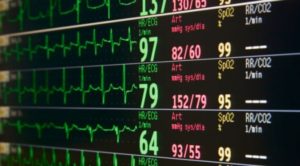
In PPAHS’ latest podcast, we spoke with Thomas W. Frederickson, MD, FACP, SFHM, MBA – lead author of the Society of Hospital Medicine RADEO guide (“Reducing Adverse Drug Events Related to Opioids”). The RADEO guide is a comprehensive clinician manual created with the aim to decrease opioid-related adverse events in an inpatient setting.
In the second part of the interview, Dr. Frederick monitoring strategies and the effectiveness of pulse oximetry and capnography. It’s an important analysis as part of developing a comprehensive monitoring strategy that warrants additional information. In this post, we’re focussing on pulse oximetry.
Monitoring with pulse oximetry can be a good strategy, says Dr. Frederickson. He cites the study conducted by Andreas H. Taenzer, MD, MS and his colleagues at Dartmouth Medical School. This study, which looked at the use of pulse oximetry monitoring in the ICU, found that it reduced rescue events by more than half (3.4 to 1.2 per 1,000 patient discharges).
Although Dr. Frederickson acknowledges the usefulness of pulse oximetry, he says that its use has limitations, stating:
“But, it’s important to keep in mind that those are parts of a comprehensive strategy. It’s not simply continuous pulse oximetry; and it is continuous pulse oximetry, it’s not intermittent pulse oximetry.
There are a number of limitations even though it can be an effective strategy.”
These limitations are discussed more in depth below:
#1. Reliance on standard pulse oximetry thresholds can cause false alarms
Alarm fatigue is one of the key limitations of pulse oximetry that Dr. Frederickson speaks about:
“[T]here’s this whole issue of alarm fatigue. Studies have shown that about one third – when pulse oximetry is deployed correctly – only about one third of the alarms are true alarm. So, it’s two thirds and a false positive or false alarms kind of contributing to this environment of alarm fatigue that our nurses are in all the time.”
Paul Curry, MD in his article, “Pulse Oximetry False Alarms on Post-Surgical Floors” argues that it is the reliance on standard alarm thresholds set for pulse oximetry monitors that is causing many false alarms. The Dartmouth study showed that post-operative patients averaged 6% of their sleep time desaturated below the 90% threshold commonly set for pulse oximetry.
#2. Decreased oxygen saturation detected by pulse oximetry can be a lagging indicator
Early in the interview, when asked about supplemental oxygen, Dr. Frederickson had this to say:
“[I]f you’re monitoring oxygen saturation as a strategy to detect respiratory failure early, you have to understand that it’s not an early warning sign – in fact is a late sign.”
Particularly in cases with supplemental oxygen administered, monitoring blood oxygenation to detect respiratory distress can alert too late. PPAHS has published several articles (such as here and here) focussing on this issue in the past. In one cited study, 72% of events of prolonged hypoxia were preceded by a drop in ETcO2, at an average of 3.7 minutes before a subsequent decrease noted by pulse oximetry.
#3. Pulse oximetry alone might not be sufficient for high-risk patients
As a result of some of the inherent limitations of pulse oximetry, it might not be a viable strategy for the most at-risk patients. Dr. Frederickson concludes this part of the interview by saying:
“So, while it can be a good strategy, I think for some patients it’s not sufficient. Perhaps for the most high risk patients, it may not be sufficient.”
This sentiment has been echoed by Anesthesia Patient Safety Foundation, which states that “Intermittent ‘spot checks’ of oxygenation (pulse oximetry) and ventilation (nursing assessment) are not adequate for reliably recognizing clinically significant evolving drug-induced respiratory depression in the postoperative period.”
—
While pulse oximetry is an integral part of monitoring for respiratory depression; however, we must remember that it is effective as part of a comprehensive monitoring strategy.
In the next post, we will look at another key component of that strategy: capnography.
Haven’t caught up with the latest interview with Dr. Frederickson?